TMS Therapy vs Theta Burst Therapy
Transcranial magnetic stimulation treatment, commonly known as TMS therapy, is a non-invasive treatment for depression and anxiety. It uses magnetic pulses to stimulate specific areas of the brain associated with mood regulation. TMS therapy success rate has been proven to be higher than traditional antidepressant medications. This article will discuss the success and side effects of TMS therapy.
Success Rate of TMS Therapy
TMS therapy has shown promising results for the treatment of depression and anxiety. According to studies, the success rate of TMS therapy is approximately 50-60%, which is significantly higher than traditional antidepressant medications. The success rate of TMS therapy may vary from person to person, depending on the severity of their condition.
Course of Treatment and Side Effects of TMS Therapy
TMS treatment usually involves daily sessions over a period of 4-6 weeks. Each session lasts approximately 30-60 minutes. During the treatment, a magnetic coil is placed on the scalp, which sends magnetic pulses to the targeted areas of the brain. Patients may experience mild discomfort during the treatment, but it is generally well-tolerated.
TMS therapy has few side effects compared to traditional antidepressant medications. The most common side effect is mild discomfort or a slight headache during the treatment. These side effects are usually temporary and resolve on their own.
TMS Therapy Success
TMS therapy success is based on individual factors, such as the severity of the condition, age, and overall health. TMS therapy may be more effective for patients who have not responded to traditional antidepressant medications. It may also be a good option for patients who cannot tolerate the side effects of medications.
What is Theta Burst Therapy?
Theta Burst Transcranial Magnetic Stimulation (TMS) is a new type of TMS therapy that has gained popularity in recent years due to its faster treatment time and lower cost compared to traditional TMS therapy. Theta burst therapy operates on similar principles to traditional TMS therapy, using electrical impulses to stimulate the mood-controlling regions of the brain. But theta-burst therapy requires much shorter exposures than repetitive TMS, which means it could offer a more efficient and convenient way to get the same quality results.
Course of Treatment and Side Effects of TMS Therapy
In traditional TMS therapy, the patient typically undergoes 20-30 minute sessions, five times a week for four to six weeks. However, with Theta Burst TMS, the treatment time is significantly reduced to only three to five minutes per session, and the overall treatment course can be completed within one to three weeks. This is achieved by using a specific TMS protocol that delivers high-frequency pulses in quick bursts, hence the name “theta burst.”
Daniel Blumberger and his research team at the Temerty Centre for Therapeutic Brain Intervention in Toronto did a series of trials comparing theta-burst therapy to repetitive TMS and found that groups treated with the two different methods did not show a significant difference in symptoms between the groups, but that both groups improved overall. This suggests that theta-burst may soon offer a new, faster way of using electrical impulses to treat depression.
The shorter treatment time and fewer sessions required for Theta Burst TMS therapy make it a more convenient option for patients, especially those who have busy schedules or live far from a TMS provider. Additionally, it is also more cost effective than traditional TMS therapy, as the shorter treatment time means that fewer sessions are required, reducing the overall cost of treatment.
Theta Burst Therapy Success
Another benefit of Theta Burst TMS therapy is that it has been found to be just as effective as traditional TMS therapy in treating depression and other mental health conditions. In fact, some studies have shown that Theta Burst TMS may even be more effective than traditional TMS therapy in certain cases.
Cost and Insurance Coverage for Theta Burst
The insurance coverage for Theta Burst TMS therapy varies depending on the patient’s insurance plan and the specific TMS provider. However, many insurance companies do cover TMS therapy, including Theta Burst TMS, for the treatment of depression and other mental health conditions. Patients should check with their insurance provider and TMS provider to determine the specific coverage options available to them.
Overall, Theta Burst TMS therapy offers a faster, more convenient, and cost-effective option for patients seeking TMS treatment for depression and other mental health conditions. Its growing popularity and insurance coverage options make it an attractive option for patients and healthcare providers alike.
Anew Era TMS & Psychiatry is a leading provider of expert TMS and psychiatric services in Southern California and Texas. TMS offers patients an additional treatment to add to their comprehensive mental health program to help conquer even the most treatment-resistant of depression cases. Allow our dedicated doctors and staff to assist you in reclaiming your quality of life. Schedule a free consultation with us today!




